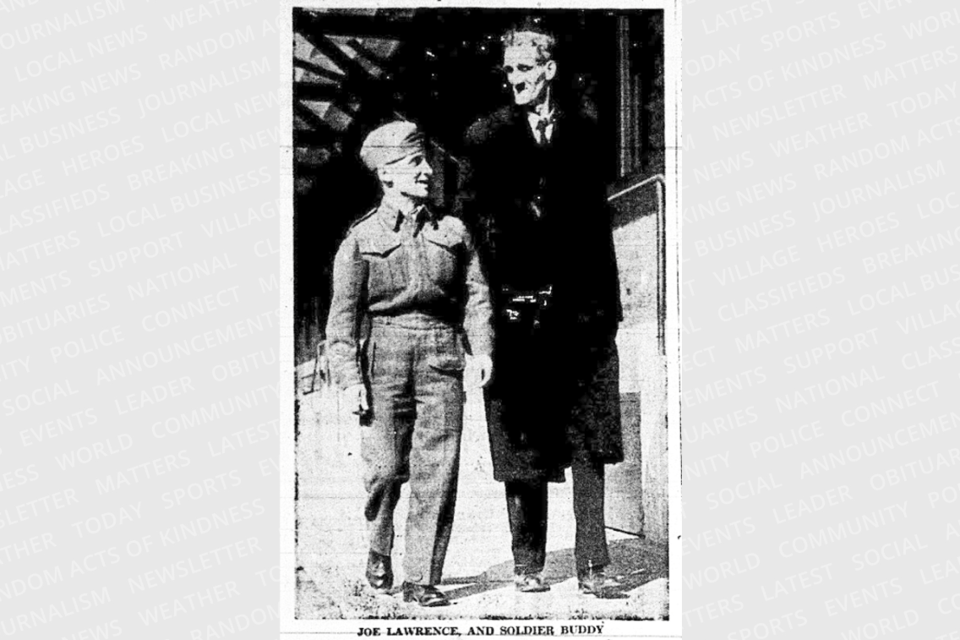Some pretty tall people have cast their long shadows across the annals of Canadian history.
Angus MacAskill (1825-1863), the famous Cape Breton Giant, stood 7’ 9” (2.36 m), and was listed in the Guinness Book of World Records as the tallest non-pathological giant on record, as well as being the world’s largest true giant. His fellow Nova Scotian, Anna Haining Swan (1846-1888), was 7’ 6” (2.29 m).
She and her husband, Martin Van Buren Bates (1837-1919) of Kentucky, who was 7’ 2” (2.18 m) travelled with a circus billed as the world’s tallest couple.
Of course, there is no shortage (pun intended) of exceptionally tall basketball players. Among the tallest Canadians on the basketball court are Zach Edey of Toronto at 7’ 4” (2.24 m) and Olivier Rioux of Montreal at 7’ 6”. At age 16, Olivier was listed by Guinness as the world’s tallest teenager.
So where does Guelph figure in all this lofty talk? According to an article in the Guelph Mercury of August 2, 1945, a local man named Joe Lawrence was the tallest Canadian soldier in the First World War. Under the headline, “Joe Lawrence Finds it Hot, Has to ‘Sleep at an Angle,’” the story claimed Lawrence was “seven feet tall in his boots.”
His attestation paper, the document recruits had to fill out when they joined the Canadian Expeditionary Force (CEF), which Lawrence signed on December 10, 1915, at the age of 33, gives his height as 6’ 10” (2.08 m). Considering that information on attestation forms wasn’t always exact, and Joe probably wasn’t wearing boots with two-inch heels (why would he?) when interviewed by the newspaper reporter, his actual height was probably between 6' 10" and 7 feet.
That’s a pretty tall soldier in anybody’s book.
He was born Joseph Johnson Lawrence in Partick, a district of Glasgow, Scotland, in 1882. His family immigrated to Canada sometime after 1900, and Joe evidently moved around the country. He lived for a while in Guelph or its vicinity, and for seven years was a member of the Wellington militia.
He also resided in Swift Current, Saskatchewan, where he served as a member of the police department. As a cop, Joe probably looked pretty intimidating. However, by the time he enlisted in the army, he was living in Calgary and was employed as a mechanic.
Joe went to the Western Front with the 2nd Canadian Division. His record shows he was not yet married, but was supporting his mother, Mary Lawrence. He fought in some of the most horrific engagements in which the CEF distinguished itself: Mt. Sorrel, the Somme, Vimy Ridge, Passchendaele and Arras.
A soldier of his stature would have made a tempting target for German snipers, and no doubt Joe would have had to be extra careful to keep his head down when he was in the trenches. But it wasn’t a bullet that eventually put Joe in the hospital.
Joe suffered from painful lower back ailments, such as lumbago, to which taller people are often particularly susceptible. Like many of his comrades, he fell victim to the curse of trench foot; a painful malady which caused a soldier’s feet to literally rot due to overexposure to cold and wet conditions. Joe
also endured the agony of hemorrhoids, which he finally had to have surgically removed. After doing his bit for king and country, Joe was given a medical discharge from the army in March of 1918.
Sometime after the war, Joe returned to Guelph where he found employment as a mechanic with the Taylor-Forbes company. The census of 1931 shows him residing in an apartment building on Woolwich Street. By that time he had a wife, Agnes (nee Dawson) who was also from Scotland; a 12-year-old daughter named Christina Jane and a five year old son named James Alfred.
Later he worked for Guelph Carpet and then Page-Hersey, and moved into a house on Havelock Street.
When the Second World War began in 1939, Joe went to London where he tried to enlist in the army again. He was almost 57, too old for military service, so he lied about his age. The attempt was spoiled by a Guelph doctor who knew Joe and had him sent back home.
Agnes died in March of 1943. She is buried in Woodlawn Memorial Park in Guelph.
“A man my size has his troubles,” Joe said in the newspaper interview two years later. It was during the sultry days of summer, and he was talking about his difficulty sleeping in a hotel bed while on a trip out of town.
“It wasn’t so much the heat, mind you. It’s the discomfort … You get into bed and you put your feet over the bed rails. Still, you’re uncomfortable. You try to double up your body. Still no good. No good at all.”
“But how did you finally fall asleep?” the reporter asked.
“Well sir, it was sort of tricky,” Joe replied. “I slept at an angle. There I was with my feet at one corner of the bed, my head at the other. Tricky, but I made out.”
Joe said he belonged to the Guelph branch of the Canadian Independent Order of Odd Fellows Association, and he proudly claimed to be that organization’s tallest member. Quite likely he was.
As for being the tallest soldier in the Canadian army during the First World War? That would be a difficult claim to prove. But we’d be willing to take the lanky Guelphite’s word for it.
Joe Lawrence eventually moved to the United States, possibly to live with one of his children. He died in Bellingham, Washington, in 1958.



